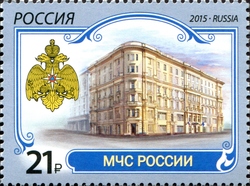Stamp: Ministry of the Russian Federation for Civil Defence, Emergencies and Elimination of Consequences of Natural Disasters (Russia 2015)
Ministry of the Russian Federation for Civil Defence, Emergencies and Elimination of Consequences of Natural Disasters (Russia 2015)
27 November (Russia ) within release Ministry of the Russian Federation for Civil Defence, Emergencies and Elimination of Consequences of Natural Disasters goes into circulation Stamp Ministry of the Russian Federation for Civil Defence, Emergencies and Elimination of Consequences of Natural Disasters face value 21 Russian ruble
| Stamp Ministry of the Russian Federation for Civil Defence, Emergencies and Elimination of Consequences of Natural Disasters in catalogues | |
|---|---|
| WADP Numbering System - WNS: | WAD:RU129.15 |
Stamp is horizontal format.
Stamp Ministry of the Russian Federation for Civil Defence, Emergencies and Elimination of Consequences of Natural Disasters it reflects the thematic directions:
Architecture (Latin architectura, from the Greek ἀρχιτέκτων arkhitekton "architect", from ἀρχι- "chief" and τέκτων "builder") is both the process and the product of planning, designing, and constructing buildings and other physical structures. Architectural works, in the material form of buildings, are often perceived as cultural symbols and as works of art. Historical civilizations are often identified with their surviving architectural achievements.
Emergency services and rescue services are organizations that ensure public safety, security, and health by addressing and resolving different emergencies. Some of these agencies exist solely for addressing certain types of emergencies, while others deal with ad hoc emergencies as part of their normal responsibilities. Many of these agencies engage in community awareness and prevention programs to help the public avoid, detect, and report emergencies effectively. Emergency services are often considered first responders, and typically have dedicated emergency vehicles.
Classical antiquity, also known as the classical era, classical period, classical age, or simply antiquity, is the period of cultural European history between the 8th century BC and the 5th century AD. It comprises the interwoven civilizations of ancient Greece and Rome, known together as the Greco-Roman world, which played a major role in shaping the culture of the Mediterranean Basin. It is the period during which ancient Greece and Rome flourished and had major influence throughout much of Europe, North Africa, and West Asia. Classical antiquity was succeeded by the period now known as late antiquity.

